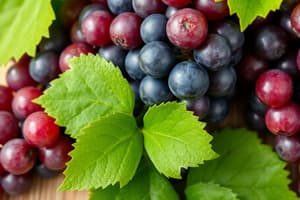Podcast
Questions and Answers
¿Cuál es una de las principales propiedades antioxidantes de los polifenoles?
¿Cuál es una de las principales propiedades antioxidantes de los polifenoles?
- Mejorar la función endotelial
- Neutralizar las especies reactivas de oxígeno (correct)
- Reducir la agregación plaquetaria
- Inhibir la producción de óxido nítrico
¿Cuál es uno de los principales beneficios cardioprotectores de los polifenoles?
¿Cuál es uno de los principales beneficios cardioprotectores de los polifenoles?
- Inhibir la producción de enzimas proinflamatorias
- Promover la apoptosis de células cancerosas
- Estimular la función neuronal
- Reducir la presión arterial (correct)
¿Cuál es una de las principales clases de polifenoles encontrada en las semillas y las paredes celulares de las plantas?
¿Cuál es una de las principales clases de polifenoles encontrada en las semillas y las paredes celulares de las plantas?
- Ácidos fenólicos
- Lignanos (correct)
- Flavonoides
- Estilbenos
¿Cuál es una de las principales funciones biológicas de los polifenoles en las plantas?
¿Cuál es una de las principales funciones biológicas de los polifenoles en las plantas?
¿Cuál es uno de los principales mecanismos por los cuales los polifenoles pueden tener propiedades neuroprotectoras?
¿Cuál es uno de los principales mecanismos por los cuales los polifenoles pueden tener propiedades neuroprotectoras?
¿Cuál es una de las principales fuentes alimenticias de polifenoles?
¿Cuál es una de las principales fuentes alimenticias de polifenoles?
¿Cuál de las siguientes afirmaciones describe correctamente una propiedad de los polifenoles?
¿Cuál de las siguientes afirmaciones describe correctamente una propiedad de los polifenoles?
¿Cuál de los siguientes beneficios para la salud se ha asociado con los polifenoles?
¿Cuál de los siguientes beneficios para la salud se ha asociado con los polifenoles?
¿Cuál de las siguientes clases de polifenoles se caracteriza por tener dos anillos aromáticos unidos por un puente de etano?
¿Cuál de las siguientes clases de polifenoles se caracteriza por tener dos anillos aromáticos unidos por un puente de etano?
¿Cuál de las siguientes fuentes alimenticias es rica en polifenoles?
¿Cuál de las siguientes fuentes alimenticias es rica en polifenoles?
¿Cuál de las siguientes funciones biológicas se atribuye a los polifenoles en las plantas?
¿Cuál de las siguientes funciones biológicas se atribuye a los polifenoles en las plantas?
¿Cuál de las siguientes clases de polifenoles incluye compuestos como las flavonas, flavonoles y antocianidinas?
¿Cuál de las siguientes clases de polifenoles incluye compuestos como las flavonas, flavonoles y antocianidinas?
Flashcards are hidden until you start studying
Study Notes
Polyphenols: Properties, Health Benefits, Types, Sources, and Biological Functions
Polyphenols are organic compounds found abundantly in various plant products. They have antioxidant properties and play crucial roles in protecting plants from environmental conditions such as UV light, pathogens, insects, and herbivores. In recent years, polyphenols have gained significant attention for their potential health benefits and various applications in the food industry due to their antioxidant properties and other physiological effects. This article explores the properties of polyphenols, their health benefits, different types, sources, biological functions, and more.
Properties of Polyphenols
Polyphenols are characterized by having multiple phenolic hydroxyl groups. They can be classified into five main classes based on their chemical structure and number of phenolic hydroxyl groups:
-
Flavonoids: The most common polyphenols, including flavones, flavonols, and anthocyanidins. They typically have two aromatic rings with three or four hydroxyl groups attached to them.
-
Phenolic acids: These include simple organic compounds with one or more hydroxyl groups attached to the benzenoid ring structure. Examples include gallic acid, caffeic acid, and ferulic acid.
-
Stilbenes: Commonly found as transresveratrol, they possess two aromatic rings joined together by a single ethane bridge.
-
Tannins: Complex polymers made up of catechins, epicatechins, procyanidins, and proteins derived from the polymerization of flavan-3-ols.
-
Lignans: Found in seeds and plant cell walls, lignans originate from the coupling of two phenolic units.
Health Benefits of Polyphenols
Research suggests that polyphenols may provide several health benefits through their antioxidant activities and modulation of signaling pathways involved in inflammation, cardiovascular diseases, neuroprotection, cancer prevention, and glucose metabolism regulation. Some key health benefits associated with polyphenols include:
-
Anti-inflammatory properties: Polyphenols have been shown to inhibit the production of pro-inflammatory molecules like nitric oxide and inflammatory enzymes such as cyclooxygenase-2 (COX-2).
-
Antioxidant activity: Polyphenols neutralize reactive oxygen species (ROS), reducing oxidative stress within cells and preventing lipid peroxidation and DNA damage.
-
Cardioprotective effect: Studies indicate that polyphenols could help lower blood pressure and cholesterol levels, improve endothelial function, reduce platelet aggregation, and protect against cardiotoxicity induced by certain drugs.
-
Neuroprotective properties: Polyphenols may play a role in reducing neuroinflammation, oxidative stress, and neuronal damage caused by glutamate excitotoxicity, potentially providing protection against neurological diseases like Parkinson's disease.
-
Anticancer effects: Polyphenols have been linked to the inhibition of tumor cell invasion and migration, induction of apoptosis, and alteration of drug resistance mechanisms in certain cancer cells.
Types of Polyphenols
As previously mentioned, polyphenols can be categorized into five main classes based on their chemical structure: flavonoids, phenolic acids, stilbenes, tannins, and lignans. Each class includes specific subgroups, such as flavone, flavanonol, anthocyanidin, gallic acid, and procyanidin among others.
Flavonoids
Flavonoids are characterized by having two aromatic rings connected by three carbon atoms. They can be further divided into several subclasses based on their chemical structure:
- Flavanones: Examples include hesperetin and naringenin.
- Flavans: These include flavone, flavanone, isoflavone, and flavanols (also known as proanthocyanidins or condensed tannins).
- Anthocyanidins: These pigments provide red, blue, and purple colors to fruits, flowers, and leaves.
Phenolic Acids
Phenolic acids are simple organic compounds containing one or more hydroxyl groups attached to the benzenoid ring structure. They can be further divided into two categories:
- Simple phenolic acids: These include gallic acid, caffeic acid, and ferulic acid.
- Hydroxycinnamic acids: These include cinnamic acid, coumaric acid, and ferulic acid.
Stilbenes
Stilbenes are characterized by being a biphenyl structure connected by an ethane bridge. The most common stilbene is trans-resveratrol, which is found in grapes and red wine.
Tannins
Tannins are complex polymers made up of catechins, epicatechins, procyanidins, and proteins derived from the polymerization of flavan-3-ols. They can be classified into two types based on their molecular weight:
- Proanthocyanidins (condensed tannins): These are found in fruits, vegetables, and grains.
- Hydrolysable tannins: These include gallotannins and ellagitannins, which are found in fruits like strawberries and raspberries.
Lignans
Lignans are derived from the coupling of two phenolic units. They are found in seeds and plant cell walls. Some common lignans include secoisolariciresinol, pinoresinol, and lariciresinol.
Sources of Polyphenols
Polyphenols are found in a variety of plant-based foods, including fruits, vegetables, nuts, seeds, and grains. Some of the richest sources of polyphenols include:
-
Fruits: Strawberries, raspberries, blueberries, blackberries, cranberries, and cherries are particularly high in polyphenols.
-
Vegetables: Onions, garlic, artichokes, broccoli, and kale contain significant amounts of polyphenols.
-
Nuts and seeds:
Studying That Suits You
Use AI to generate personalized quizzes and flashcards to suit your learning preferences.




